As my dive buddy and I cruised over an expanse of sand and rubble, our exhaust bubbles trailed upward to the surface some 60 feet over our heads. We were scouring the bottom on a “Lembeh Straits” muck dive, looking for a diversity of creatures that seem to litter the terrain in this region. The bottom sloped gently, extending out toward the drop-off some 100 yards away. We moved slowly, keeping an eye out for movement or a discrepancy in shape or color against the sand that might suggest a possible subject worth investigating. We swam only inches from the bottom, our fins moving so slowly that they barely disturbed the top layer of sand.
My vision swept over an inconspicuous clam shell, which was open just a crack. As I passed by, it slammed shut and then ever so slowly started re-opening. I quickly decided this might deserve a closer look, and pivoted to get a better look. As I drifted toward the shell and with my face mask only inches away, I discovered a pair of eyes looking intently back at me from inside the shell.
I tweaked my buoyancy and steadied my camera, using my reef stick as a tri-pod. I slowed my breathing, waiting to see what would happen next. The shell continued to open revealing a smallish coconut octopus pushing the top of theshell upward with two of its arms as it watched me intently. What happened then was an absolutely amazing display of the behavior and ability of this highly skilled creature. The diminutive octopus extended a couple of its arms out of the shell and out onto the sand. With an incredible display of strength and dexterity, it literally stood on two of its arms and hoisted its shell above its head and began walking across the sand. From its markings I quickly identified the creature as a Coconut Octopus. As I watched, amazed, I reviewed what I knew of this animal.
The Coconut Octopus, Amphioctopus marginatus, also known as the veined octopus, is a medium-sized cephalopod commonly found in tropical waters of the western Pacific Ocean. It commonly preys upon shrimp, crabs, and clams, and commonly displays unusual behaviors including bipedal walking and the use of tools (gathering coconut shells and seashells and using these for shelter).
For many centuries, biologists have asserted that only human beings were capable of making tools. After all, this is what gave us the advantage needed to become the dominant species on the planet. However, over time it was learned that other species also use rudimentary tools. For example, Chimpanzees use sticks to “fish” for termites. However, that type of behavior was viewed as rudimentary or unsophisticated. ‘Sticks’ were single-purpose tools that didn’t involve much creativity and did not involve much in terms of collection, planning and preparation. Then additional observational studies of the coconut octopus in the mid-1960’s turned many of these prior theories regarding tool building by animals on their head.
The coconut octopus has been observed to be a tool maker. That alone is enough to make the species interesting. If you are an octopus enthusiast like I am, the coconut octopus will continually leave you going, “wow, did I just see that!”
The coconut octopus is found in the western Pacific and Indian oceans. It prefers shallow coastal waters and spends the majority of its time on the sandy or muddy seafloor close to the shoreline.
This species also shows a preference for calmer waters as opposed to the swifter seas of the open ocean. This is why it is frequently found in bays, lagoons, and other inlets. I have been fortunate to encounter these fascinating animals in popular muck diving destinations like the Lembeh Straits in Indonesia and Dumaguete in the Philippines.
The coconut octopus is on the smaller end of the spectrum in terms of body size, rarely larger than six inches in length. The head alone, is approximately three inches in length. Because it is a soft-tissue creature, the full bodyweight of an adult coconut octopus rarely reaches ten ounces.
As with most octopuses, the coconut octopus can quickly change the color and texture of its skin to match its immediate surroundings. When not occupied in the process of camouflage, the coconut octopus usually appears dark brownish and occasionally an orange/cream color. Its color pattern is marked by darker branching lines which take on a vein-like form. The skin color on the outer edges of its arms also seem to be darker. The suckers, on the other hand, are almost white and really stick out when the creature dons a darker color, making the species easily recognizable. Thesiphon, the tube-like structure on its head that the creature uses to draw water into its gills and expel it for fast spurts, is usually lighter in color, often a yellowish/cream color.
When hunting its usual diet of shrimp and crabs, the coconut octopus adopts one of two predatory styles. Sometimes it will actively seek out prey and position itself to pounce on the prey, a technique sometimes referred to as foraging. Indoing so, it grabs the other creature with its arms and brings it to its mouth as fast as possible. This is done in order to pierce the prey with its beak. The beak of the coconut octopus is the only rigid part of its body. It is very strong and canpuncture or rip through the exoskeleton of arthropods, such as crabs and shrimp, while also being able to pry open theshells of clams. Dusk and dawn are the preferred hours for active hunting on the part of the coconut octopus.
When the coconut octopus is in a passive hunting mode it will usually be in its den or improvised field shelter…like a coconut shell or clam shell. It can also be burrowed in the sand or mud of the seafloor with only its eyes sticking out. During those moments, the coconut octopus will emerge suddenly and catch unsuspecting prey by surprise if they come within easy reach. This style of passive hunting can take place at any time of the day or night.
The coconut octopus has one of the longer life spans for small-sized octopuses. They normally live for three to five years. The primary contributing factor to determining their life span is when they decide to mate. The coconut octopus reaches sexual maturity between 18 and 24 months of age. Once a male mates, he will die soon thereafter. This takes place within weeks — sometimes days. The female can continue living for months or years. She will die only after she has laid her eggs and they have hatched.
The mating ritual of the coconut octopus employs a “the faster the better” approach. Males prefer to insert their sperm packet with their specialized “sex arm” into the mantle of the female as quickly as possible. This to avoid having their seven free arms from becoming entangled with the female. When a male and female coconut octopus do become involved in a more complex mating dance, it has been observed in the wild that the females often strangle the male and then eat him. That’s definitely not the sort of dinner date that you ever want to have. To avoid being eaten, male coconut octopuses employ the “mate and dash” technique. Some also disguise themselves as females in order to stand a chance while approaching.
Now to get back to what I deem the most interesting behaviors…..
As I previously stated, the coconut octopus has been observed to be a tool maker. That alone is enough to make the species interesting. However, like a skilled showman who wants to deliver more pizzazz to his audience, so too does the coconut octopus deliver more.
We, as humans, are bipedal. In other words, we walk on two legs, which is our primary means of locomotion. In nature, most creatures will walk on four legs if they walk at all. Not so with the coconut Octopus, which takes on the challenge of bipedalism. Several of you may wonder how a creature that lacks a skeleton, whose body is basically a large head and eight arms, can walk? Especially when this creature lives the entirety of its life underwater.
It is important to understand that the coconut octopus, like all octopuses, is a highly cognitive and intelligent creature. Over the course of millions of years of evolution, octopuses have evolved a standard set of locomotion. Most animalsstick with what nature has provided for them. Octopuses, like humans, however, constantly try to improve on nature.
The coconut octopus can funnel water through its siphon to create streams of water that can propel it at high speed in the blink of an eye. This is perfect when the coconut octopus has to flee from danger. It can also swim through the water using its arms to propel itself. This is an energy-efficient way to coast from spot to spot. It is, however, the third method of octopus locomotion that the coconut octopus leaves our jaws dropping. This species of octopus has the ability to use its arms to walk on the seafloor. This action usually involves using several pairs or all of its arms. The method is efficient as a strolling action.
The coconut octopus takes its ability to walk with its arms to a whole new level. Not only can it use the method common with other species, but it can also walk on two extended arms alone. This emulates the bipedalism of us humans. Its motivation was probably not for the purpose of mimicking humans, but so that it can carry its mobile home on its head. What they are in fact doing is using the coconut as a form of shield and camouflage. When the coconut shell on their head is combined with the specific motion created by its bipedal walking, it creates the perfect cover. Seen from above, the coconut shell moving along the ocean floor does not raise suspicion from potential predators of the coconut octopus’ movements. This is because when coconut shells sink to the bottom, they are frequently moved and tossed about by even the gentlest of water currents. The coconut octopus replicates this natural occurrence and uses it as an effective way to shield its movements.
Using coconut shells as a head shield while engaging in bipedal walking can accurately be described as a form of tool usage. After all, it is using the coconut shell as both a helmet and a camouflaging device. The coconut octopus, however, doesn’t stop there. This species of octopus will actively search for coconut shells and empty clamshells of different sizes. It does so because it is able to recognize that different sized shells have different uses. Some are useful as the camouflaging helmets that it uses when walking. Others are useful as shields against lateral attacks. And others, when used in tandem, make for excellent building blocks for shelters.
This means that the coconut octopus is selective in the raw materials that it uses for its tools. Imagine yourself at Home Depot on a Saturday afternoon spending hours finding the right tools and the right materials for your weekend project. Coconut octopuses use the same level of care in selecting their materials. In spite of its common name, the coconut octopus does not limit itself to coconut shells when it comes to tools. They also use clamshells and discarded containers left behind by humans. To say is that a specific species of octopus is smart is really saying something. All of the octopus species are very intelligent, but the Coconut Octopus is on a different level. Despite its small size it is huge in ability and intelligence. For my buck, this is one of the most incredible animals I have been privileged to observe.


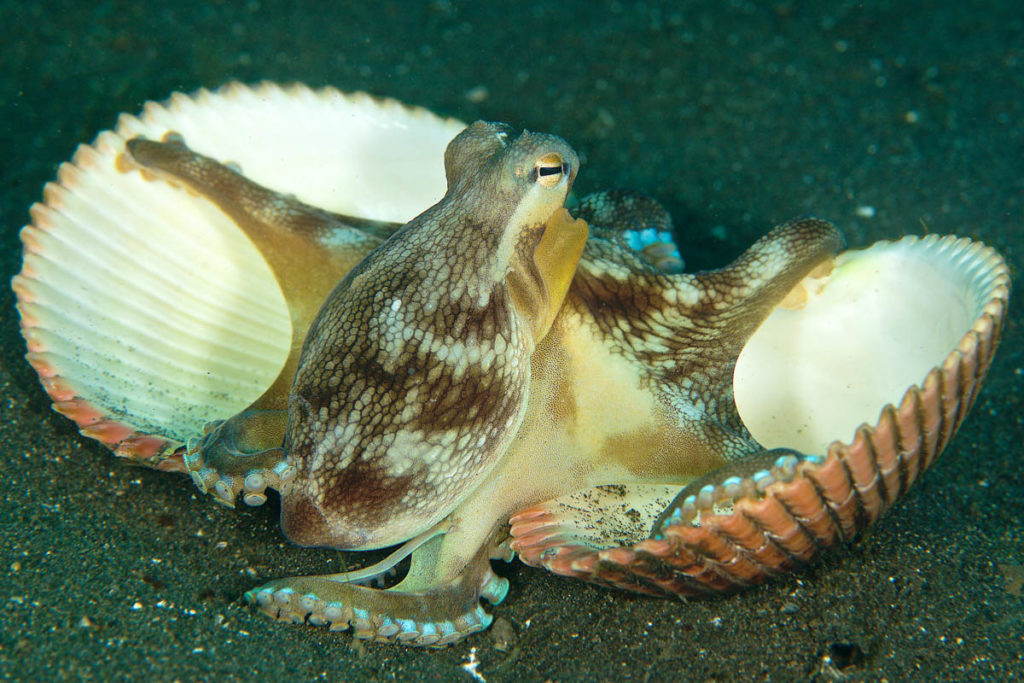


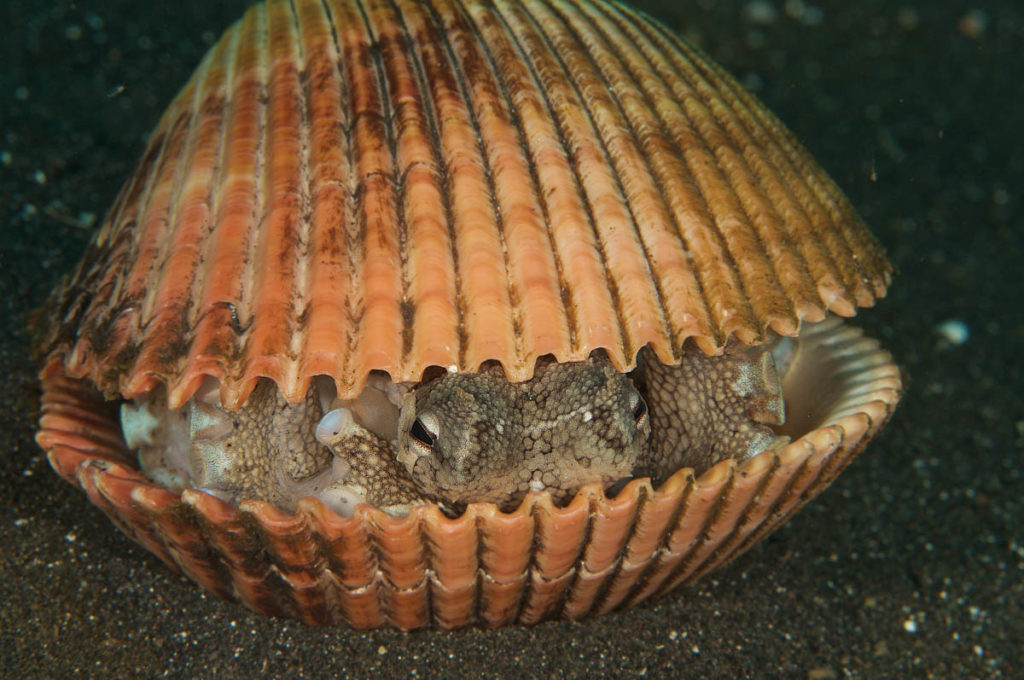

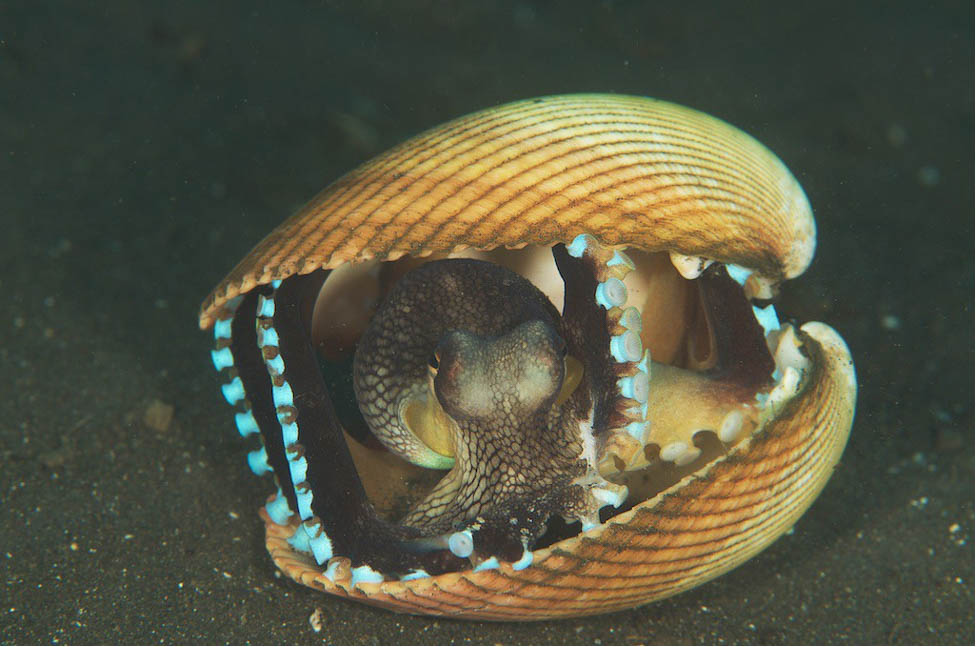
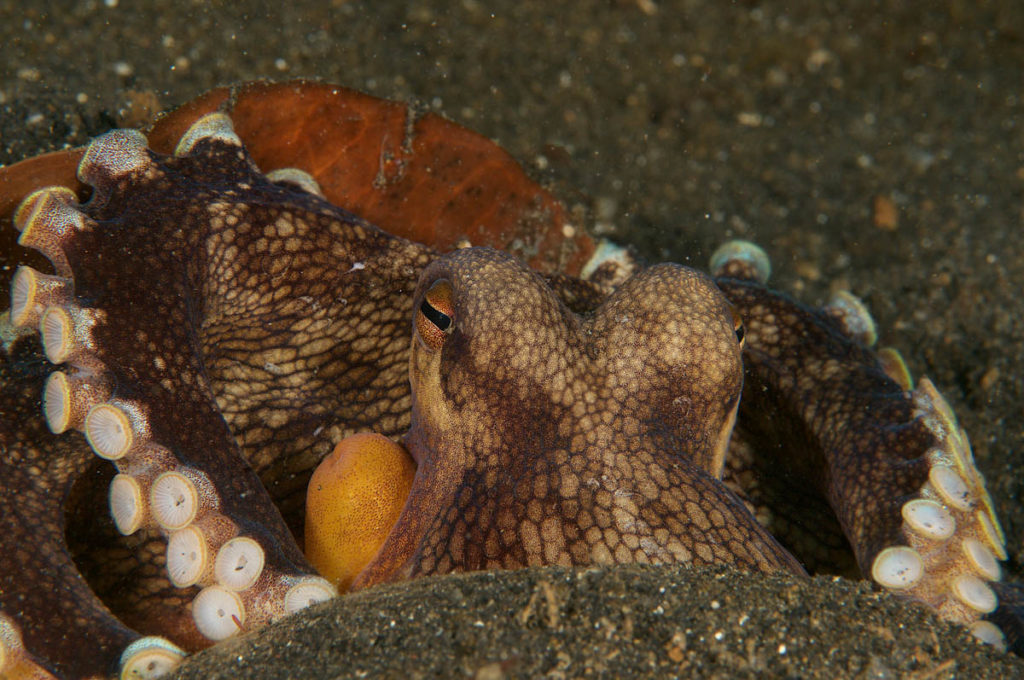
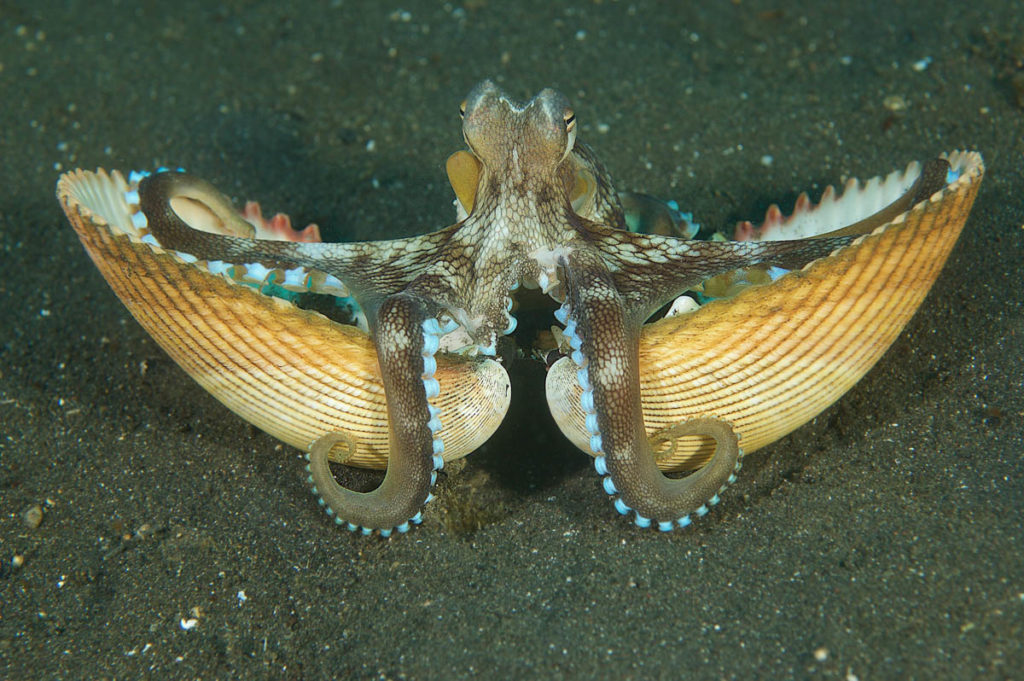
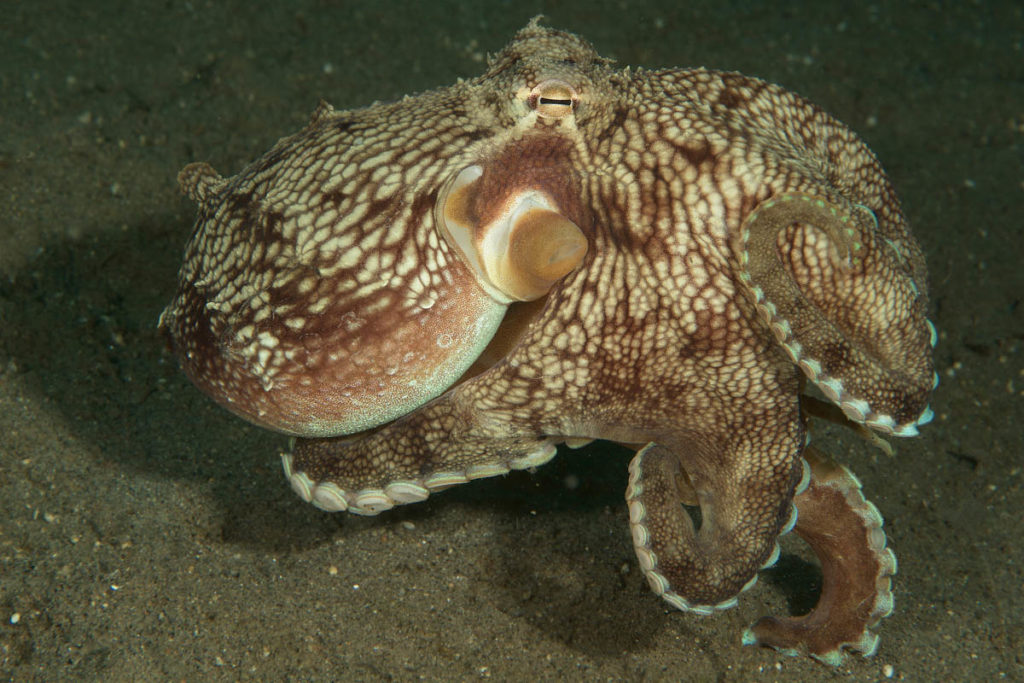
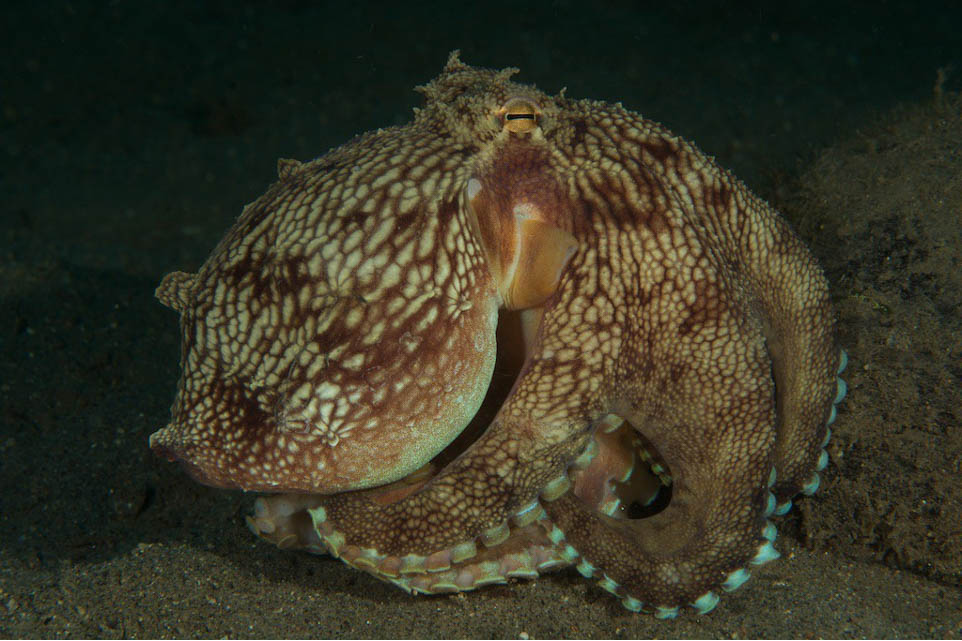
1 Comment
WOW!! I’ve just watched My Octopus Teacher, and now this! Thank you for sharing your amazing experience!